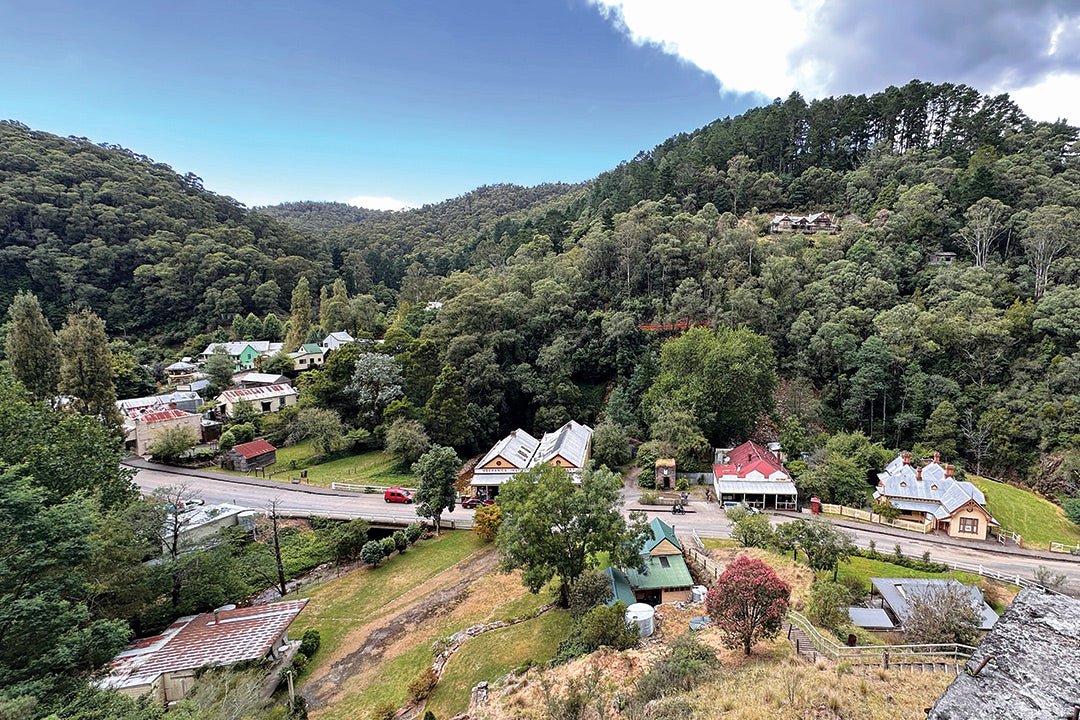

Hidden in a remote valley in West Gippsland is a tiny one-street town whose population once peaked at 3500 people. Now, just 16 permanent residents call Walhalla home, but the spring of its boom days can be felt at every step.
‘Quaint’ doesn’t really do Walhalla justice. The small town appears frozen in the late 1800s, its one main road lined with old weatherboard and brick buildings — a general store, pub, fire station, post office and cutesy cottages among them. Forested valley walls peppered with lush tree ferns rise steeply on either side, and though the town is not technically located at a dead end, the road beyond is unsealed and far less-used. And as it is located only 2.5-hours from Melbourne, it makes for a great day trip or weekend stay to enjoy lovely walks, rugged mountains and a whole variety of outdoor activities and historic sites.
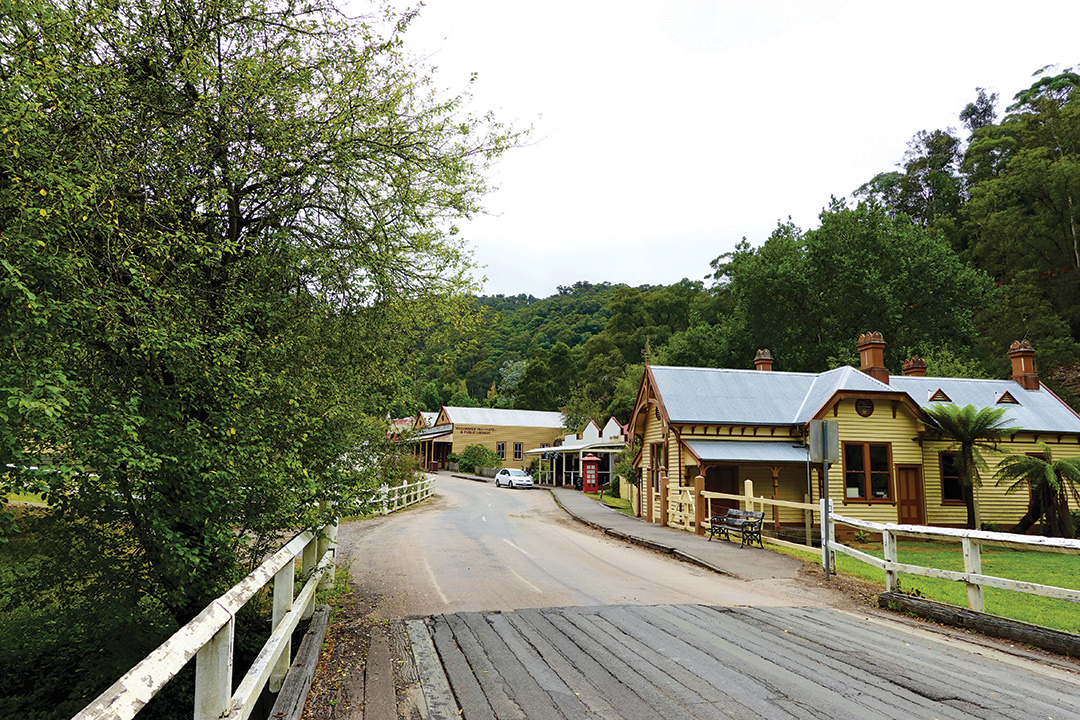
Walhalla's story began in 1863 when Edward Stringer discovered gold in what is now Stringers Creek, running alongside Main Road. Within a few months a tent city sprang up for the tsunami of prospectors who came to try their luck, and one of those earliest and most profitable mines was Walhalla Gold Mine. Its Scandinavian-born manager, Henry Rosales, is believed to have taken inspiration from ‘Valhalla’ in Norse mythology — the blissful resting place of heroes killed in battle, presided over by the god Odin — and by 1866, the name Walhalla had been adopted for the entire town.
When gold started drying up in 1914, the mines began closing, and despite a few decades of further exploration, the town was on a gradual decline. That was, until the 1980s when a string of extensive restoration projects saw Walhalla’s renaissance as a tourism destination.
Going underground
More than 50 tonnes of gold have been pulled out of Walhalla’s mines over the years, worth more than $3 billion in today’s money. Mining was the town’s raison d’etre and to fully appreciate the challenges involved back in the day, you need to go underground.
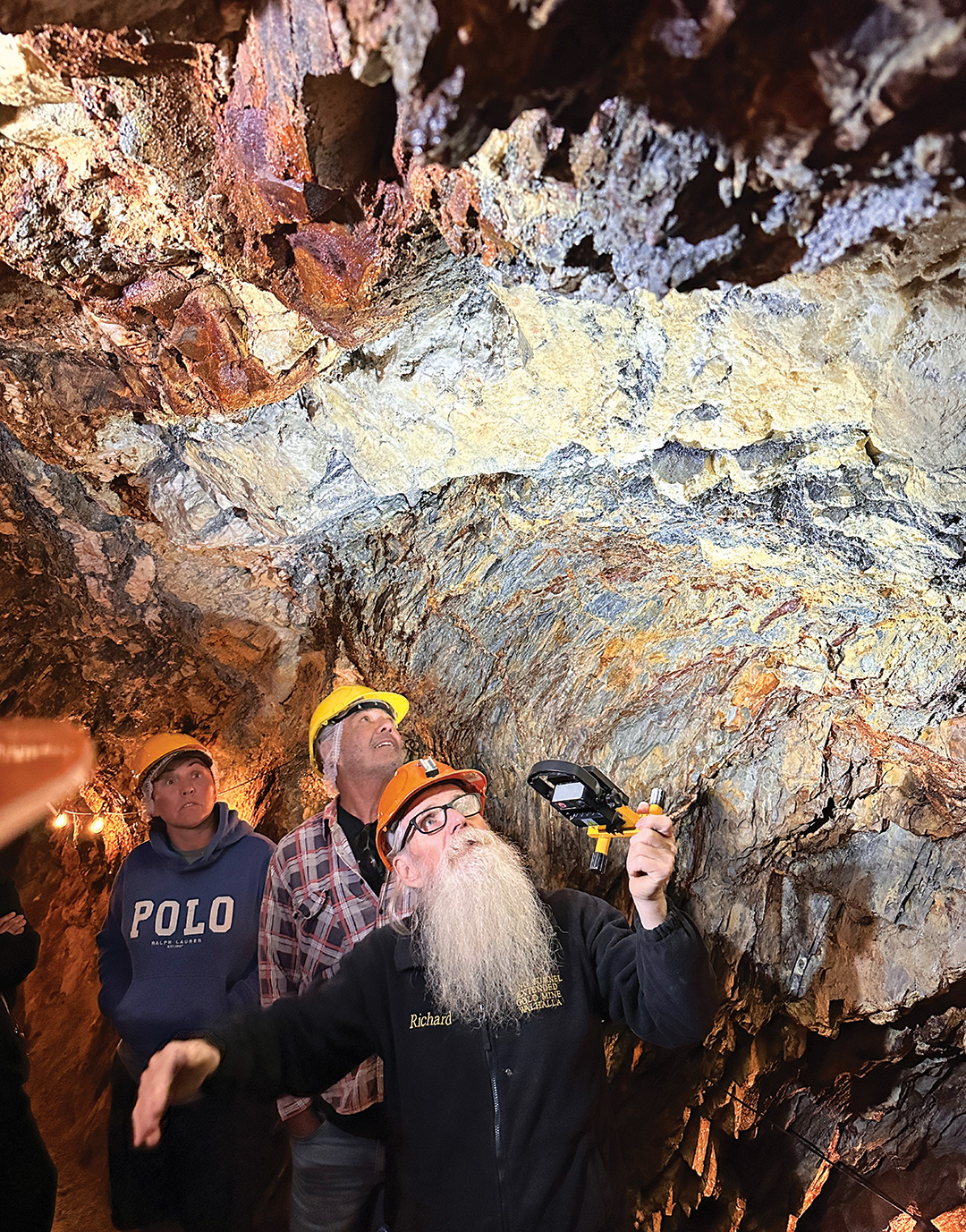
An enlightening 45-minute guided tour of the Long Tunnel Extended Gold Mine shows the original workings and machinery of what was once Victoria’s richest gold mine — all up, it produced 13.7 tonnes, worth about $1.3b. The tunnel maze extends up to 1120m deep, but the tours follow a fairly easily accessible route cut into the hill from ground level, and during the walk the guides paint a picture of a tough and dangerous industry.
Operations ran 24 hours a day, excluding Sundays, with miners working eight-hour shifts without break. Mining techniques evolved over time, but started with a hammer and chisel by candlelight, powered simply on a billy of tea. Feet were wrapped in fatty rags to protect against the water the miners stood in and teams of six workers took a week to progress a mere metre into the rock.
With quartz dust saturating their lungs, most were dead by the age of 28, until they worked out how to inject water while drilling, to dampen the dust. By 1903, generators supplied electricity underground and miners were progressing six metres per week using jackhammers powered by compressed air, thanks to five hungry boilers that ended up burning every tree within 8km (not that you’d know it now).
Ironically, thanks to the mines, Walhalla was one of the Australia’s first towns to have a few electric streetlights (until the mines closed), yet also the last mainland town to be connected to the electricity grid in 1998. There are still no streetlights.
On foot
Fresh air and sunshine are very much appreciated after a stint underground, and there are plenty of excellent walks in and around Walhalla to stretch the legs.
It’s hard to resist the town’s pretty streetscape so start with a walk along Main Street where you’ll pass about 30 landmarks and historic buildings with interpretive signs that really bring to life the stories of Walhalla’s history and residents. These signs flag notable locations such as the unmissable Brass Band Rotunda and the remains of the old bank vault, along with the impressive house of stonemason Johannes Gloz and the dinky weatherboard Spetts Cottage.
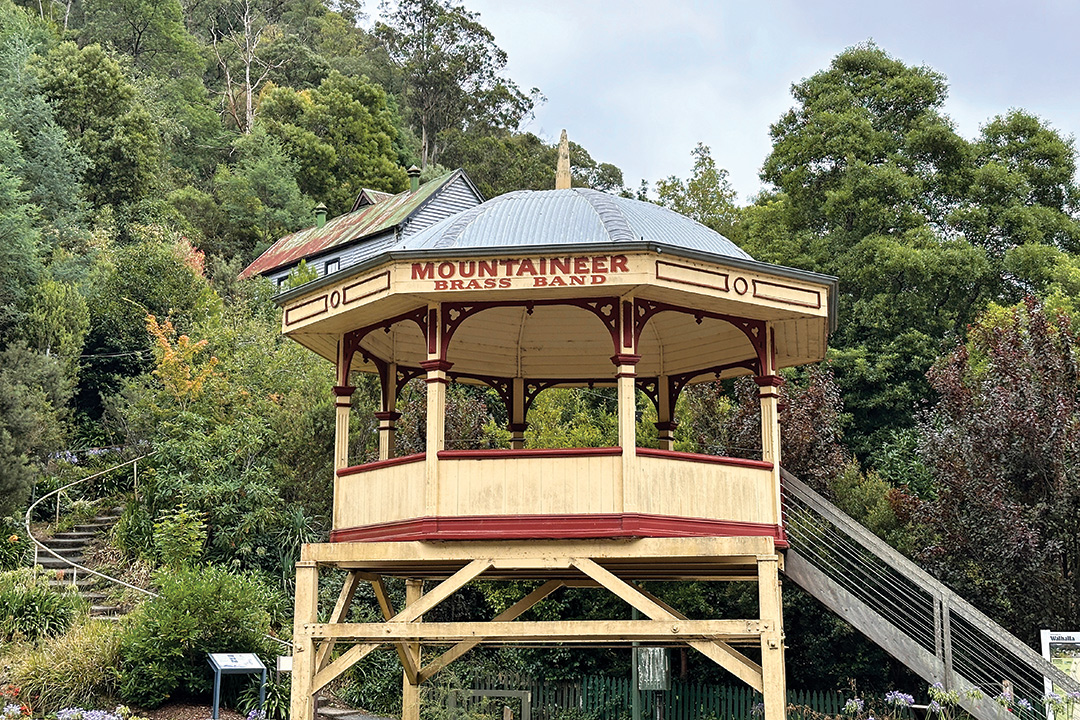
The accompanying stories range from the humorous to the tragic: a cow once wandered into the third-floor level door of the Grand Junction Hotel and had to be led down two flights of stairs to exit out the front; a picture of the unfortunate Sarah Ann Hanks’ badly disfigured face from smallpox accompanies a tale of how her house was burned to ashes after her death to prevent the virus from spreading.
It’s hard to imagine the mining residents had much energy left for recreation, but a string of entertaining signs zigzag uphill along a pretty trail leading to the cricket ground. With flat ground at a premium in the valley, the residents lopped the top off a hill to create this landmark.
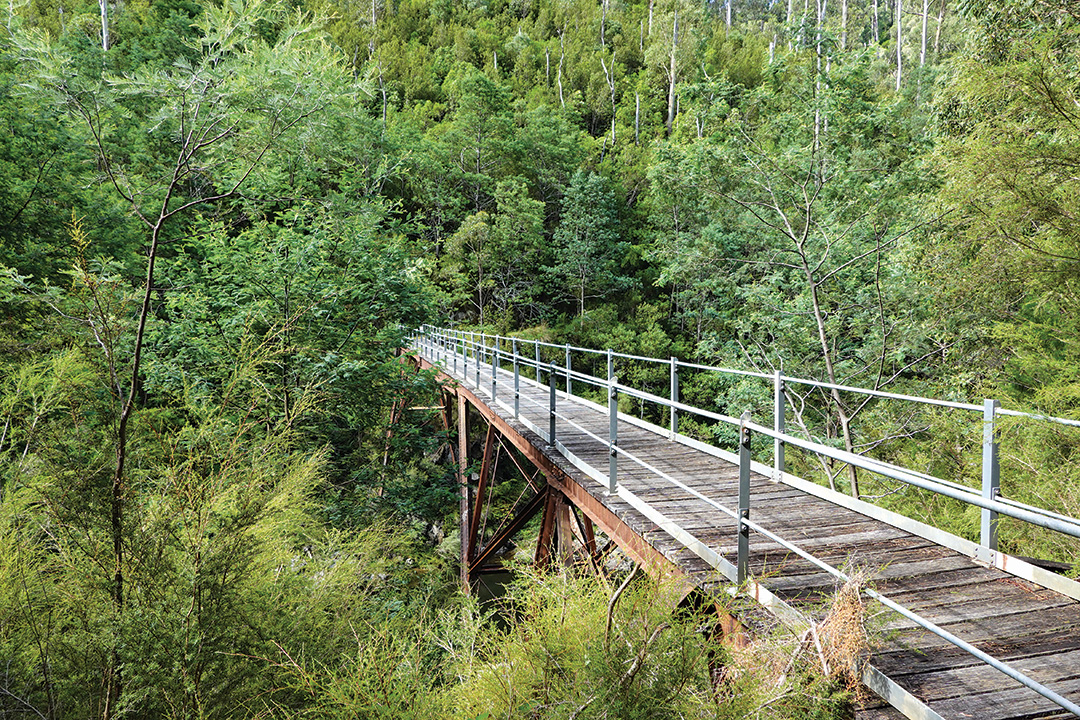
The Tramline Walk sidles above the town, providing spectacular views over the town of Walhalla, but if you really want to immerse yourself in Walhalla’s (thankfully, regrown) forests, start at Thomson Station and hike the one hour 45-minute return track to Poverty Point Bridge. Shadowing the Thomson River, it’s a gorgeous amble of tree ferns and cascades, and the sound of lyrebirds is never far away.
All aboard
It’s unfortunate that a rail line built to service the mining community and opened to great fanfare in 1910 faced the closure of most mines a mere four years later. With gold running out and the subsequent rapid drop in population, the service limped along for several decades until finally ceasing in 1944.
While the line once connected Walhalla with Moe, 42km south, fortunately a section of the narrow-gauge railway has been restored and reopened as the Walhalla Goldfields Railway. Pulled by diesel locomotive, it makes a spectacular ride.
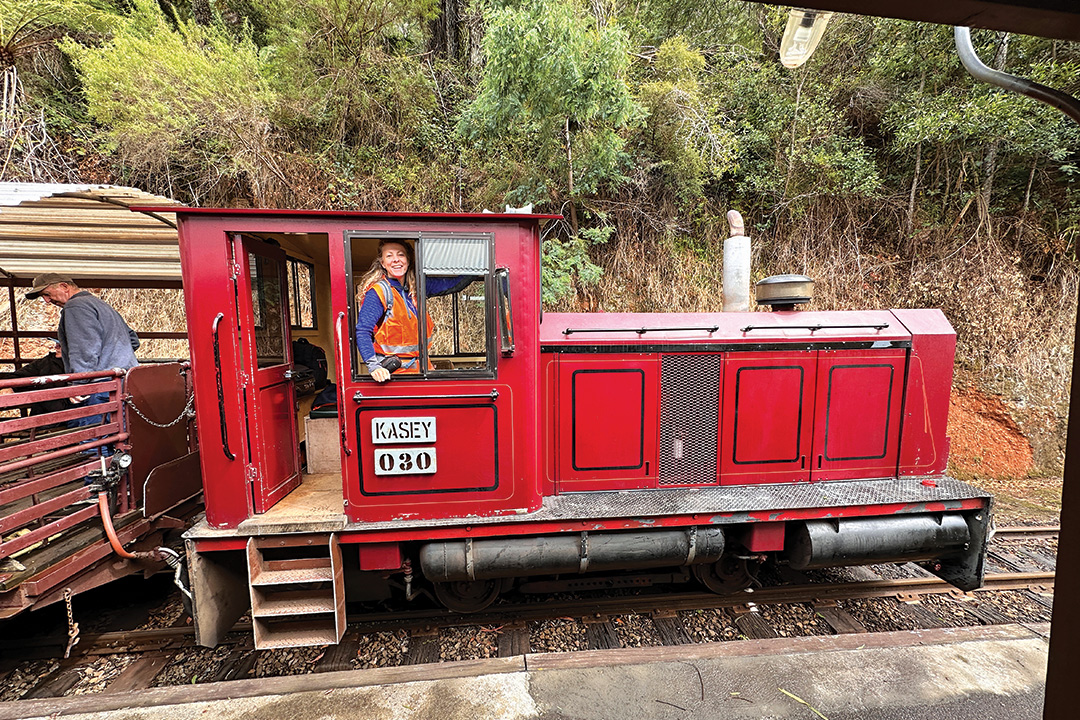
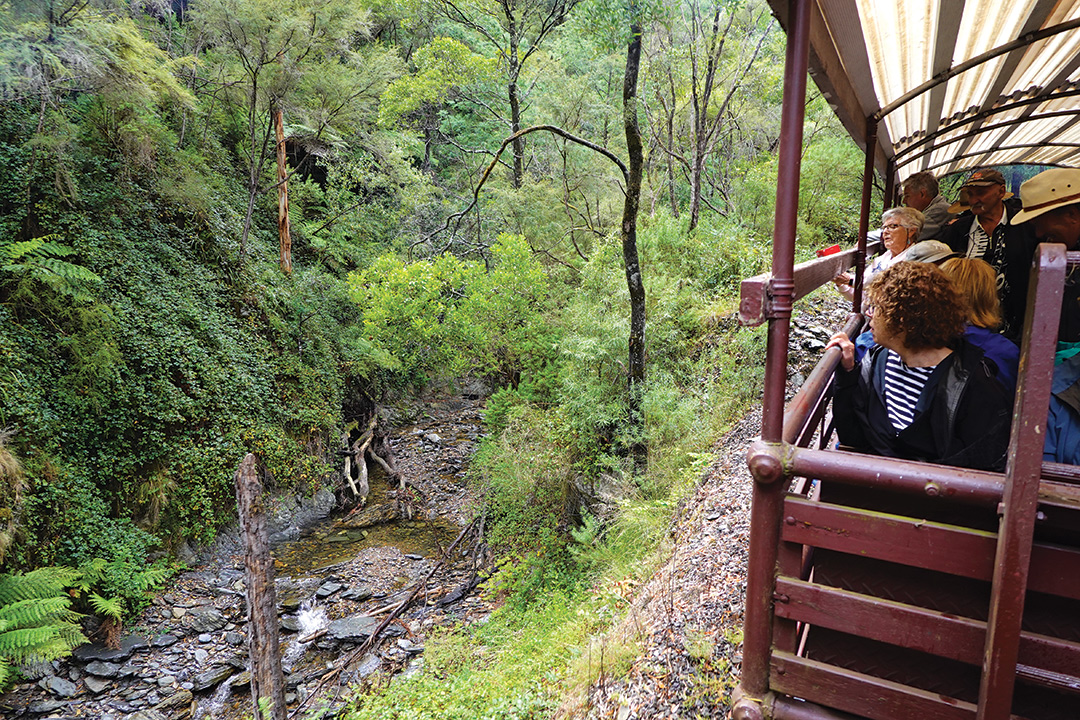
From Walhalla to Thomson (a tiny station on the Thomson River) takes an hour return, and every second of it is a feast of stunning scenery. Following a deep gorge cut by Stringers Creek, it passes over a series of eight trestle bridges, through shale rock cuttings and atop ledges of dry-stone walls made by hand over 100 years ago. The pace is slow, providing plenty of time to appreciate lush forest, tree ferns, water cascades and rock formations, either from an indoor or open-air carriage.
Adventures up high
You could easily soak in Walhalla’s peaceful beauty but just under an hour’s drive away is a diversion not to be missed. Mount Baw Baw, in Baw Baw National Park, is Melbourne’s closest ski resort and in summer it becomes a playground for hikers and bikers who revel in its network of well-marked trails.
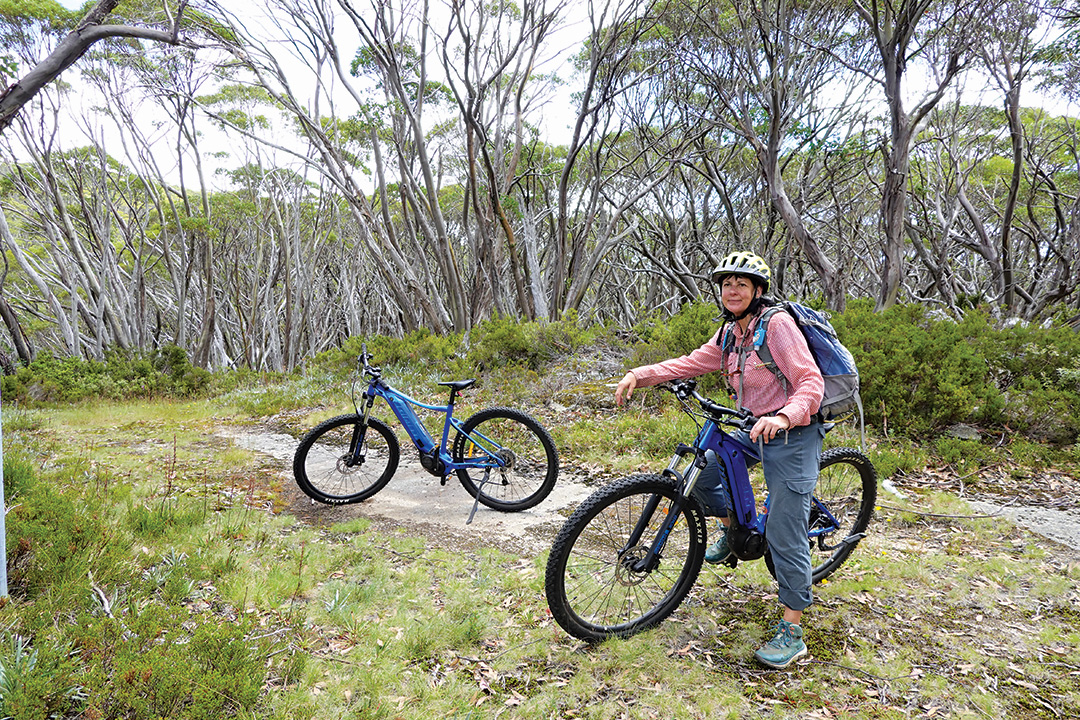
It’s all super picturesque, the landscape decorated with gnarled and silvery snow gums, grassy plateaus and scenic lookouts gazing over distant valleys. Especially beautiful is the panorama from Mueller’s Lookout, near the summit. There's a picnic area with a table which makes it a great place for an extended break.
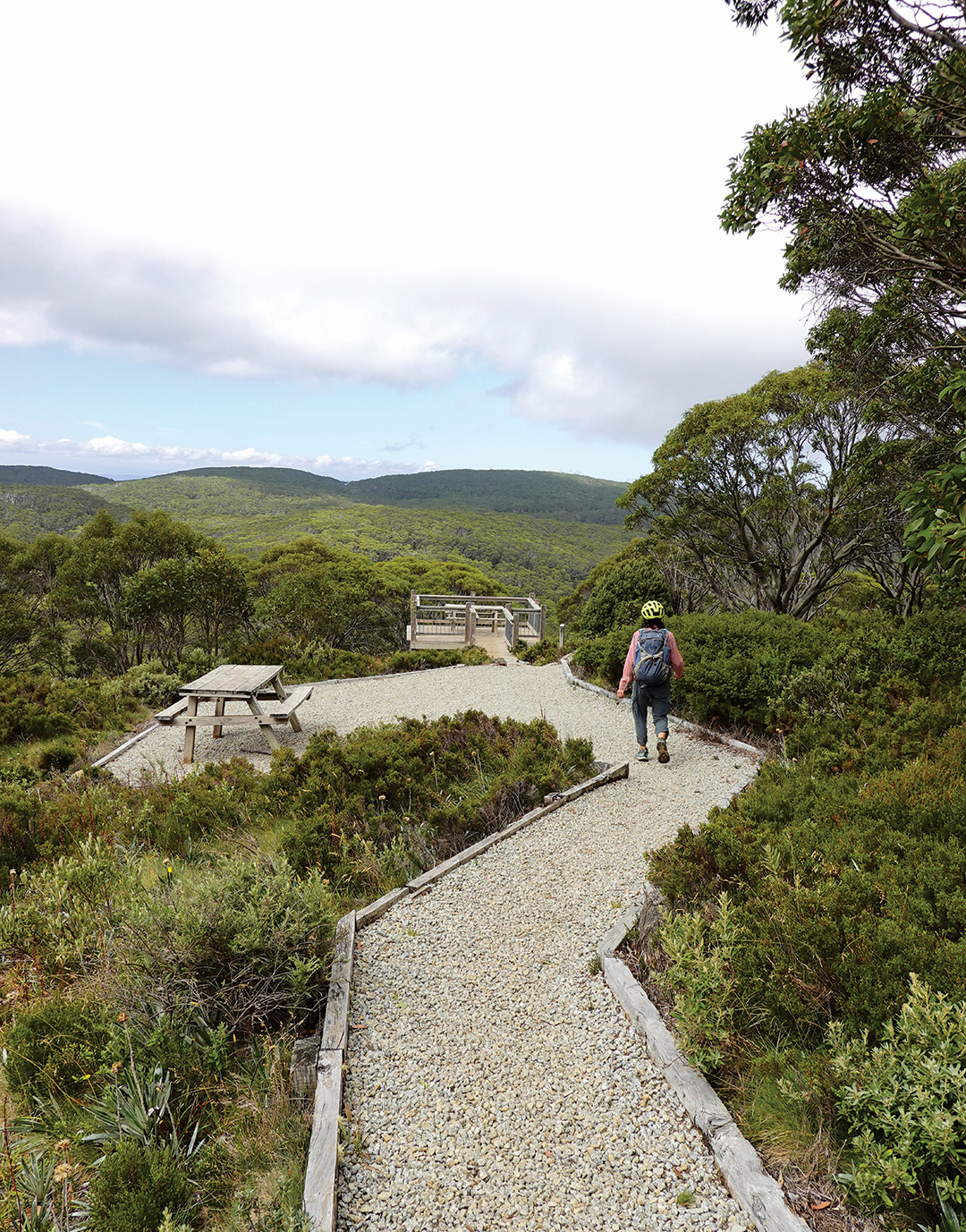
Trails are graded easy to advanced — many are cross country ski trails in winter — and exploring them by bike will let you cover a lot of ground. If you’re a purist take your own mountain bike, but for maximum excitement with minimum effort, rent an e-bike from the village centre. No matter your fitness, these pedal-assist bikes will get you up the hills and over rough and rocky terrain with ease. It’s super fun! If you're after a long walk with overnight stays, try out the Upper Yarra Walking Track.
Also on the mountain is a rare treat in the Mount Baw Baw’s Dingo Resource Centre, situated in the village. A sizeable natural enclosure is built around tree scrub along with granite outcrops that the three resident dingoes enjoy perching on.
You can usually walk past and get a glimpse of the Baw Baw dingo family, Rowdy, Warragul and Bunji, but if you want to spend decent time with them, take them for a walk, and maybe have a cuddle, book a private dingo encounter. These run on demand for groups of up to five people and cost $200 with proceeds helping to support dingo education programs. Fifth-generation bred in captivity (essentially from rescue backgrounds), the dogs are quite sociable, although handlers will tell you there are some people they just do not warm to.
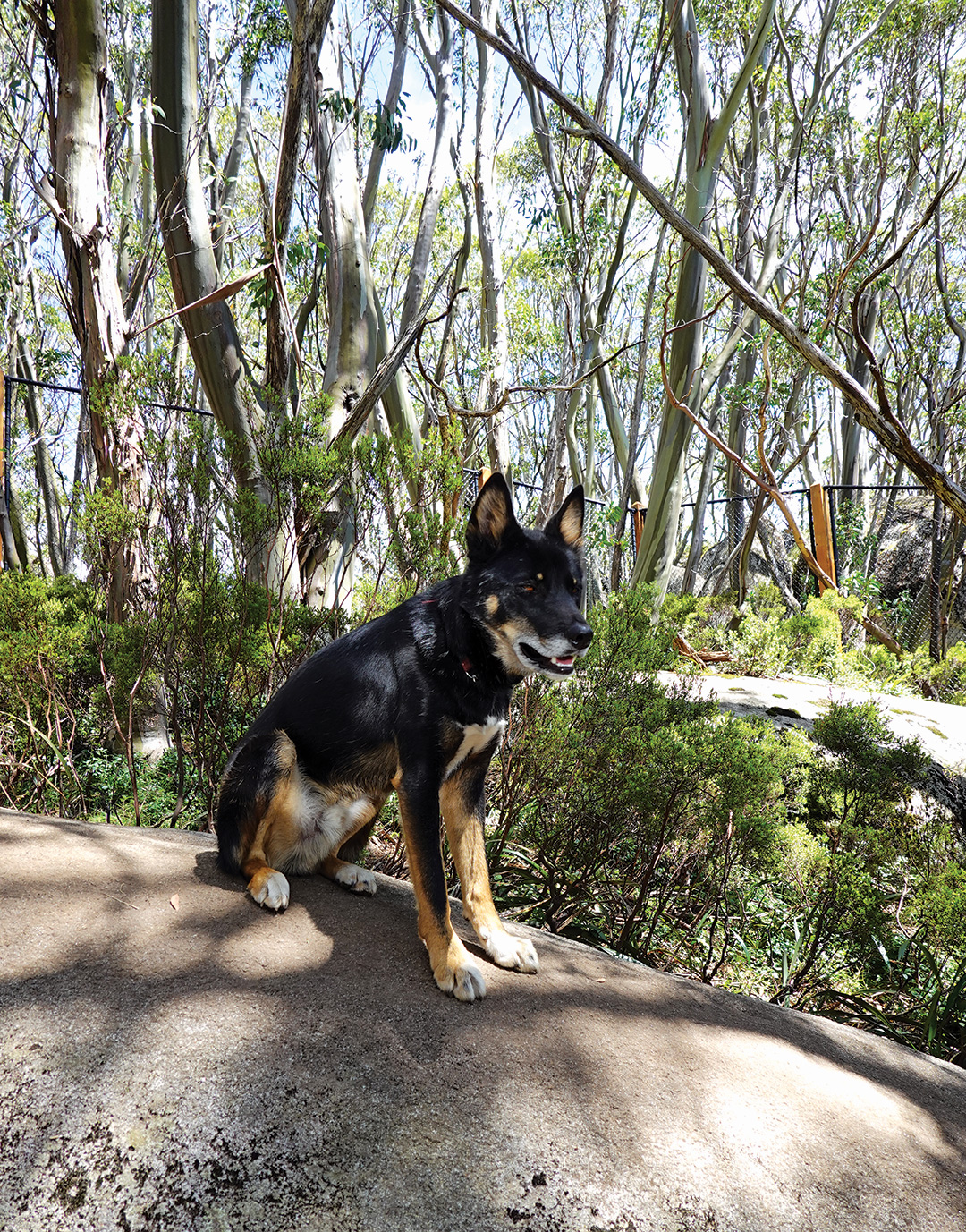
Warragul (aka ‘Gully’) is 100 per cent alpine dingo, having a thicker coat and bushier tail than her tropical or desert cousins, an evolutionary feature which helps to keep her and any puppies warm; Rowdy is a desert/alpine dingo mix; young Bunji is pure alpine. Handlers share interesting insights about these important apex predators, such as how their double-jointed limbs help them negotiate difficult terrain and the fact that their heads can flip back 180 degrees — handy for spotting tasty birds in the trees.
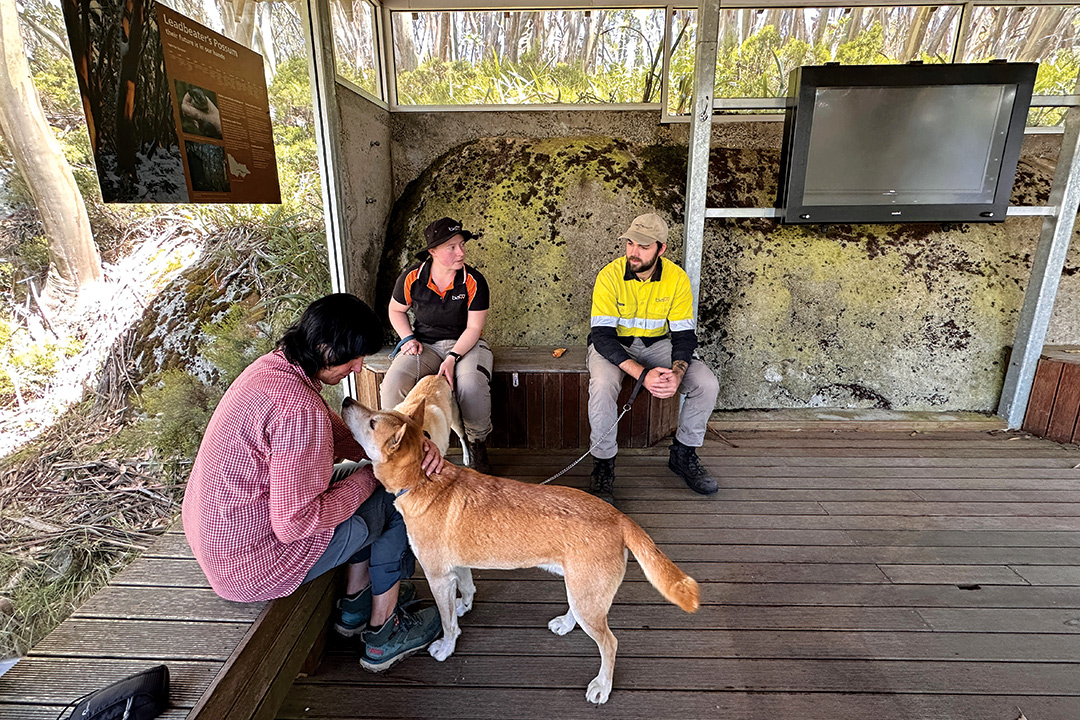
Mushroom Rocks
On the Baw Baw Plateau, halfway between Walhalla and Mount Baw Baw, is Mushroom Rocks, so called because they sprout from the ground like a cluster of mushrooms. These impressive granite tors were formed from molten magma that bubbled and cooled deep underground about 360 million years ago, later exposed by weathering.
The Australian Alps Walking Track runs 655km atop the Great Dividing Range between Walhalla and Canberra, but for those who aren’t up to such an extensive trek, walking a 3km return section of it from Mount Erica car park gets you to the rocks and takes under two hours (known as the Mushroom Rocks Walk). Continue a little further through beautiful snow gums to reach the summit of Mount Erica.
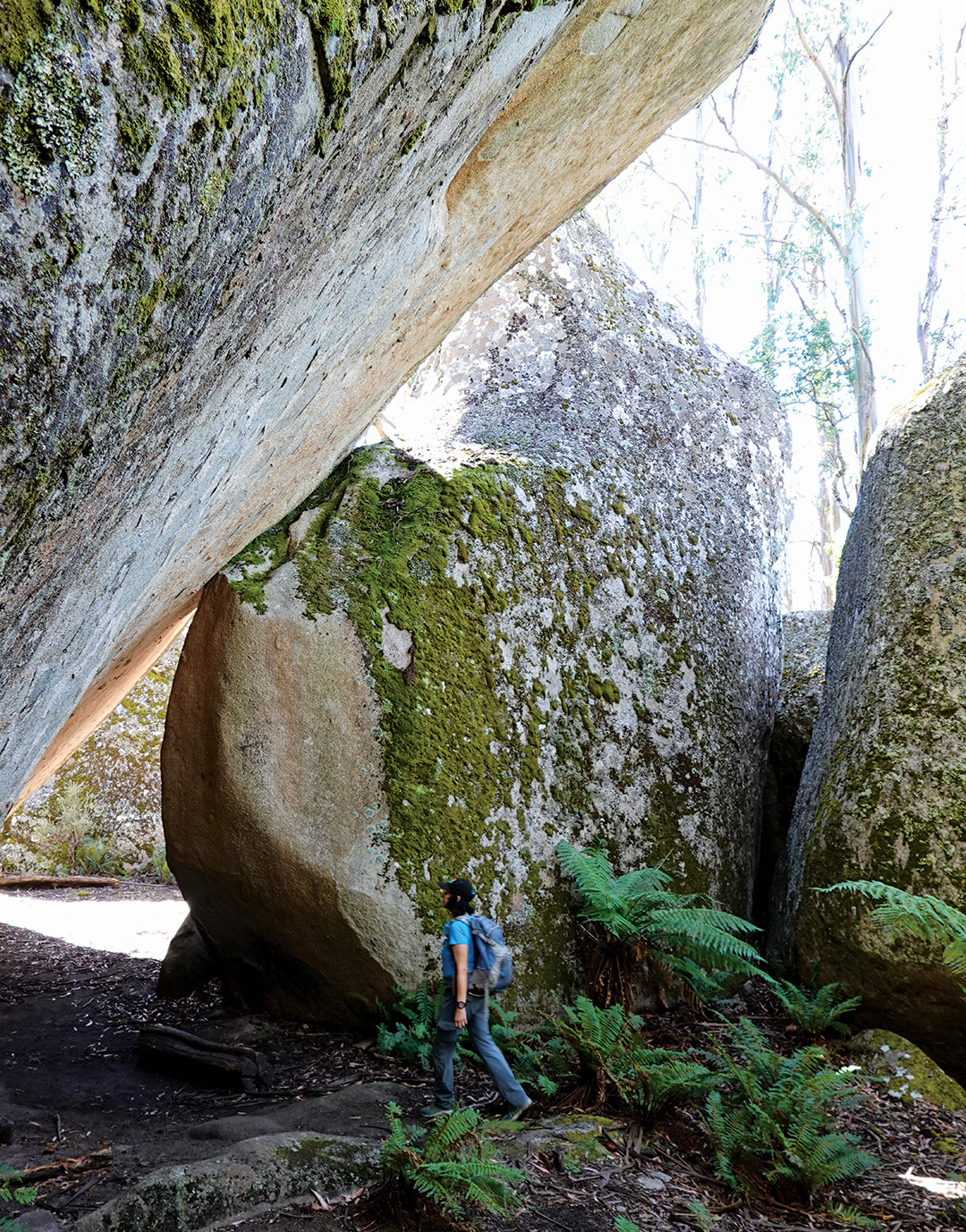
The trail is narrow, climbing gradually through lush ferns and a forest of mountain ash and silver wattle. Superb lyrebirds are common (you’ll hear them before you see them), as are crimson rosellas, but when you reach the rocks it’s the towering granite maze smeared with emerald moss that captivates most. Misty mornings make it even more magical. Allow time to explore around them and soak up the atmosphere of this special location that’s drawn visitors since gold mining days and Aboriginal peoples for thousands of years before that.
Fast facts
Stay
- North Gardens camping ground has free grassy camping with toilets, gas barbecues and fireplaces (no showers).
- For a small fee, Chinese Gardens Camping Ground (closed at the time of writer’s visit) is set on Stringers Creek and has showers.
- Fifteen minutes-drive away is Coopers Creek Reserve, an idyllic site on the Thomson River and surrounded by tree ferns and mountain ash. It’s free, has toilets and picnic tables, and the location is great for swimming or launching a kayak or canoe (check out the Thomson River Canoe Trail). Note, there’s a short section of fairly narrow, winding and unsealed road to reach it.
- If you'd like to enjoy the conveniences of a caravan park, go to Erica Caravan Park, a 20-minute drive from Walhalla.
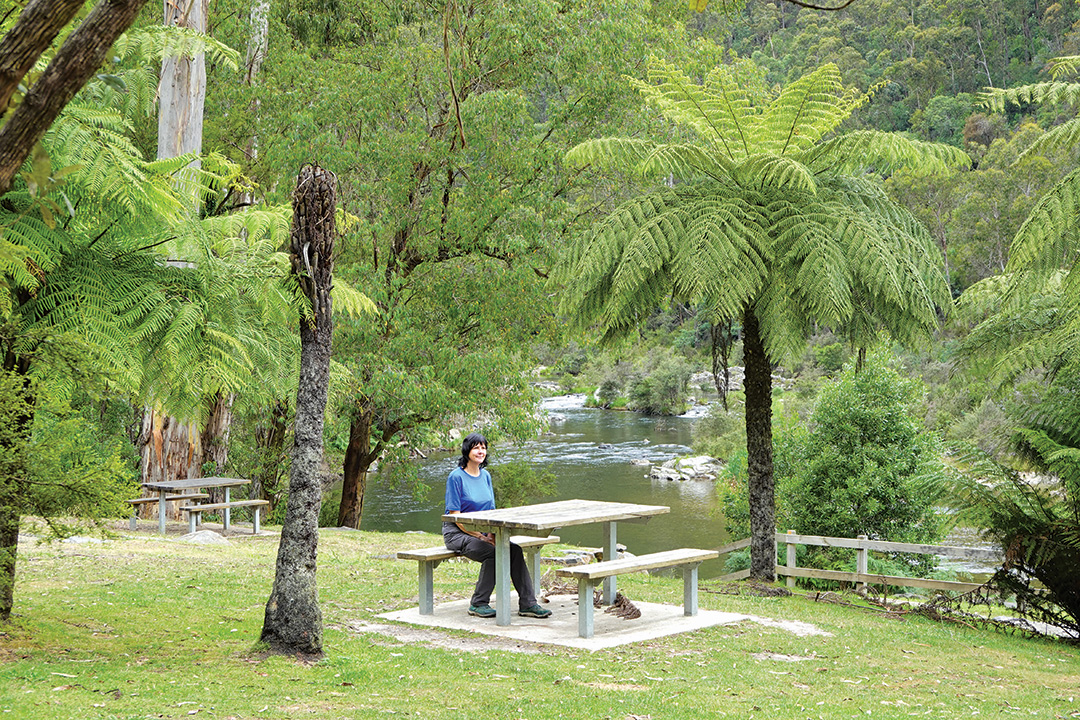 Coopers Creek Reserve
Coopers Creek Reserve
Eat and drink
There are three places to eat in town (four, if you count the Olde Lolly Shoppe): Walhalla Witchery does scrumptious toasties and homemade cakes, Walhalla Goods Shed Cafe offers everything from sandwiches to burgers and chips, and the Wally Pub is best for beer garden drinks or standard pub fare.
Things to do
- Hop aboard the scenic Walhalla Goldfields Railway; dogs are welcome. For a small extra fee you can sit up front with the driver.
- The Long Tunnel Extended Gold Mine tour offers an enlightening insight into the life of miners.
- Ample walks range from short ambles such as the scenic Tramline track overlooking town, to a 90-minute hike to Mushroom Rocks, complete with ferns and lyrebirds.
- Explore Mount Baw Baw’s trails on foot or by bike or visit the Dingo Resource Centre for a rare opportunity to meet dingos and take them for a walk ().
More info
Head to the Visit Gippsland website for more inspiration.
The writer travelled as a guest of Destination Gippsland.
If you want to learn the latest caravan news, find the most innovative new caravans and camping gear or get inspired to plan your next adventure to some of Australia's best getaway destinations, subscribe to our weekly newsletter. We promise to send you only the best content.
Related Articles:
Exploring East Gippsland, Victoria







